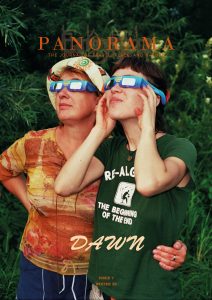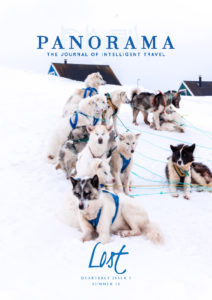Rising like Himalayan peaks, four bamboo poles square the altar and pierce the fog. Between swings a canopy, a red ruffled valley cradling gifts for the deities. Underneath, on earth sanctified with cow dung plaster, Brahman priests have diagrammed the cosmos in pink and yellow powders. They dole out offerings: marigolds, coins, cooked rice. In a pit in the middle, the sacred fire of Agni crackles, spits and flares.
Bundled in coats and scarves, dozens of guests crowd the courtyard. A few talk on mobile phones. Many cluster in small groups to catch up on neighbourhood news: ailing elders, marriage arrangements, sons and daughters working in Dubai, the United Arab Emirates, Malaysia. Others discuss the burning national questions of early 2007 in Nepal: How many protestors died in Birganj? Will the Maoists take up arms again? Will King Gyanendra stay or go? How long will the transportation strike last?
I retreat into the house to get ready. My nieces help me remember how to wrap a sari. They approve my earring and bangle choices and smudge my eyelids with kohl. I draw the line at lipstick.
Back outside, the journey is about to begin. Guests end their conversations, pocket their mobile phones, and girdle the altar.
Waiting for further instructions, I prepare for a role that many here in the village tell me I’ve been destined to play for nineteen years: witnessing my son’s rebirth into manhood.
An American who fell in love with a Nepali educator in graduate school, I gave my son his first birth here nineteen years earlier. Friends and acquaintances in the US have often asked what that was like. I find it hard to give a short answer for my naive attempt at home birth among high caste Hindus in a loft over a buffalo shed: the cultural confusion, forty hours of painful but inefficient contractions, forty-five minutes in a motor rickshaw to the nearest hospital, more hours on a Pitocin drip, delirium, shaking so intense after delivery that I couldn’t hold my newborn for some time.
For years I’ve said: “Like climbing Mt. Everest, but harder.”
Yet I have no idea what it is like to climb Mt. Everest. I’ve spent most of my time in Nepal in the plains, not the mountains, and have only glimpsed Everest while flying in and out of Kathmandu.
Back in the plains again, my latest role in this country famed for adventure travel, requires me to wear a sari and stand still in the kitchen doorway.
Relatives swaddle my son in a yellow loincloth and tie a yellow bandana over his cropped black hair. They hitch yellow pouches off the end of a long pole balanced over Amalesh’s shoulder. The yellow, I’ve read, echoes the mother’s placenta. But this man-made one is so much tidier than the first.
Leaving aside some envy for mountain travellers, I could pile on reasons why I’ve compared my son’s first birth to a Mt. Everest ascent: to subvert the man versus mountain narrative, focus on women’s stories, highlight demographic changes shifting the majority of Nepal’s population out of the mountains and onto the plains. I could toss on statistical comparisons of those killed on Everest against those who die in childbirth. Risking an avalanche of the absurd, I might round up lists of what Google tells me people compare to climbing Mt. Everest (building a career, quitting cigarettes, stepping up into your truck) or giving birth (finishing a marathon, writing a book, getting a tattoo). Birth and Everest might share the most as free-falling cliches.
Feet bare and staff in hand, Amalesh now looks the part of a wayfarer provisioned long before our era of boots, backpacks, and freeze-dried foods. He is a ritual stand-in for all the high caste boys over the centuries who had to beg for alms so they could afford meals, lodging and guru fees in Varanasi or some other distant learning centre.
Months earlier, as I debated whether to make the 7,000-mile journey to Nepal from my home in Oregon, USA, relatives reminded me that the mother is more necessary than the father at a sacred thread initiation. This ritualised alms-begging is one of the reasons why.
Beside me at the threshold stands Amalesh’s grandmother. She wears a green and white widow’s sari and a shawl curled around her head. On the first of three rounds of the altar, Amalesh stops before us. We wait for him to say the words.
“Bhiksam bhavati dehi,” a cousin whispers in his ear. Whichever honourable person is present, please give alms.
“Biksa bava.…what?” Amalesh looks around for help. His grandmother coaches him on the Sanskrit pronunciation. With his tongue trained in American English, he struggles with the aspirated “bh” in two consecutive words. After several tries, he manages it. Satisfied, Parvati nods to me. We each put bananas, tangerines and one measure of polished rice into the yellow pouches.
My son continues on, rounding the altar clockwise to receive fruit and rupees from others cheering him forward.
For more than two thousand years, the footsteps of pilgrims have mapped spiritual practices and stories onto South Asian geography. A pradakshina (circumambulation) might circuit the subcontinent (these days, by air-conditioned video coach) or it could be a domestic altar. But by circling some cosmic axis, anyone can tap into the divinity of continuous flow and constant change.
A trip around Shiva’s abode, Mt. Kailash, would be the pradakshina of a lifetime for my son’s Shaivite-leaning relatives. Of course, costs, rugged landscapes, and Chinese travel restrictions mean that few do it. Kailash may be the closest earthly reflection of the cosmic Mt. Meru. Believed to be eighty-five times greater than the earth’s diameter, Meru is so vastly imagined that even those who prefer ascending rather than circling peaks might as well put away crampons, pickaxes, and oxygen tanks and turn inward.
In the alms-begging, each orbit re-enacts grander sacred journeys and also unhitches another point on the cord binding son to mother.
Polishing his pronunciation, Amalesh walks and chants until the words run together: Bhikshambhavatidehibhikshambhavatidehibhikshambhavati…. He stops often so relatives and neighbours can give more gifts.
Three times Amalesh stops at the kitchen door and begs. His grandmother pauses each time and stays my hand as well. She has to judge whether his request is sincere. She nods then doles out another measure of rice. I do the same.
After the alms-begging, Amalesh joins priests as well as uncles and cousins at the altar again. Neither Brahman nor married to Amalesh’s father anymore, I sit on a bench nearby. I love how this ritual weaves my son into his Nepali family and heritage even as I cringe at how it reinforces caste and gender inequalities.
Mobile phones come back out. Conversations grow louder. Many worry now about those who have not yet arrived. Because of the transportation strike, no one will make it through by bus today.
Soon, Amalesh will put on his sacred thread and join the “twice-born” castes. Then he’ll trade his unstitched clothing for travelling gear: a kurta and salwar and umbrella. I’ll tidy my sari and stand still again, calling my son back from another ritual journey––this time to the gazebo, our home’s stand-in for Varanasi.
Throughout this second birth, my role feels less like climbing a mountain and more like anchoring the belay line, holding the still point from which the son can break away. Throughout the day, priests set new routes to male ancestors, male descendants yet to come, and The Vedas.
Agni, the hearth centre of the household, burns on, his smoke curling up around the altar peaks and mingling with the fog.











